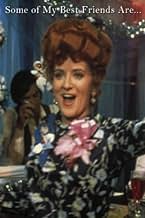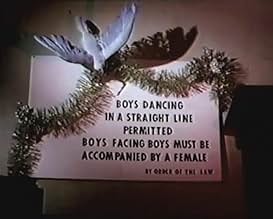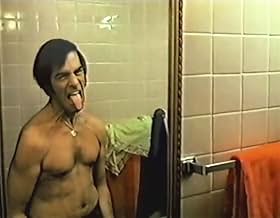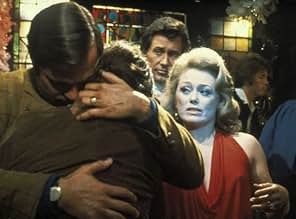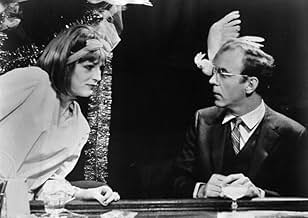Aggiungi una trama nella tua linguaA dramatic expose of the lives of a group of gays who meet in a New York City bar on Christmas Eve.A dramatic expose of the lives of a group of gays who meet in a New York City bar on Christmas Eve.A dramatic expose of the lives of a group of gays who meet in a New York City bar on Christmas Eve.
James Murdock
- Clint
- (as David Baker)
Robert Christian
- Eric
- (as Rob Christian)
Nick De Noia
- Phil Drew
- (as Nick DeNoia)
Thomas Fiorello
- Ernie
- (as Tommy Fiorello)
Recensioni in evidenza
Yes, 1970s gay life was no picnic but it was not as bad as presented in this dark movie. But I suppose it could be this way in some situations. Too bad it was not more balanced through use of some positive characters. I was surprised to see some long-time as well as up-and-coming entertainers in this movie: Carlton, Rue and Gil. And the filming technique resembled the handheld shooting technique of more recent horror movies.
This film now plays a lot of gay film festivals..billed as.... " The movie you love to hate"! Of course it now looks very politically incorrect. But there was a time that it really was like this. I know..I was there! P.S. It's so much fun to see so many people who went on to greater things. Michael Bluegrass
It's two years past Stonewall and now certainly a story like Some Of My Best Friends Are could now be put on the screen. Still it was only a very few straight
players who would cast in a gay film. You will see however a couple of adventurous souls you might recognize from the cast.
This film if anything shows Stonewall was for the young. The young gay men hanging out at the Blue Jay bar on Christmas Eve aren't content to live life as was ordained by the sexual orientation and their elders up to now. Not sure of where the direction is going, but the younger ones don't want to settle.
The older ones are scared. Not just of the dominant straight society oppression. If anything they're afraid that the young with their agitation and demonstrations will bring down unwanted attention. The older gay men in this film are deeply closeted and are afraid of the door being even slightly ajar.
The fact that back in the day the gay bars were mob controlled was certainly noted. One of the great changes in the past 50 years was first the fact that the mob ran fewer and fewer of these establishments. And then as the community developed non-alcoholic venues bars themselves began to decline. Probably a good thing because drinking establishments everywhere by their nature bring gloom after the high wears off.
Some Of My Best Friends Are is kind of an expanded version of gay life in the early 70s that Boys In The Band showed in the middle 60s. One wonders how that group of gay men would have taken to Stonewall.
This film if anything shows Stonewall was for the young. The young gay men hanging out at the Blue Jay bar on Christmas Eve aren't content to live life as was ordained by the sexual orientation and their elders up to now. Not sure of where the direction is going, but the younger ones don't want to settle.
The older ones are scared. Not just of the dominant straight society oppression. If anything they're afraid that the young with their agitation and demonstrations will bring down unwanted attention. The older gay men in this film are deeply closeted and are afraid of the door being even slightly ajar.
The fact that back in the day the gay bars were mob controlled was certainly noted. One of the great changes in the past 50 years was first the fact that the mob ran fewer and fewer of these establishments. And then as the community developed non-alcoholic venues bars themselves began to decline. Probably a good thing because drinking establishments everywhere by their nature bring gloom after the high wears off.
Some Of My Best Friends Are is kind of an expanded version of gay life in the early 70s that Boys In The Band showed in the middle 60s. One wonders how that group of gay men would have taken to Stonewall.
I wish we knew more about Mervyn Nelson, the writer and director of this one... apparently he wrote a ground-breaking film on jazz around 1950, and another ground-breaking chapter of gay life back in the day. This is totally a snapshot of gay (mostly underground at the time) life in 1971. some drag, some straight-acting, some camp. and a thank you to a very young Rue McClanahan and Fannie Flagg for being a part of this. This is a good picture of people in a gay bar at various stages of acceptance; some are at peace with who they are... some are in denial, some are having conversations about being unsure of just where things are in their life. Christmas Eve, in a gay bar. Emotions. The hustler chooses a dance partner, but then has buyer's remorse. Fights. Ups, Downs. laughter. sorrow. Probably the biggest name here is Gary Sandy, much better known as the station manager in WKRP. and Gil Gerard was also Buck Rogers. It wasn't an easy time for gay folk. even the bars could be dangerous, two years after the stonewall riots in New York City. an honest look at gay life in the city, back in the day. Good stuff. an honest picture of gay life in 1971.
It's Christmas Eve at a gay bar in Greenwich Village.
It's a portrait of a bunch of isolated people who, in one of the ending statements, have nowhere else to go. The range of characters run from flashy queens all the way to uptight New Englanders who don't do anything about their sexuality but talk about it. The bar is owned by a woman who presides like a mother at a party; her staff is mostly middle-aged men who go home to their wives. There's an undercurrent of sadness under the almost hysterical holiday partying. Like many of the cheap movies of the era -- of any era, really -- the cast includes actors years after their cinematic prime, like Carleton Carpenter, the current stars of queer cinema, like Candy Darling, and performers before they became well known, like Fannie Flagg, Gil Gerard, and Rue McClanahan.
In the end, Christmas Eve is no time to be alone, and these people are more alone than most.
It's a portrait of a bunch of isolated people who, in one of the ending statements, have nowhere else to go. The range of characters run from flashy queens all the way to uptight New Englanders who don't do anything about their sexuality but talk about it. The bar is owned by a woman who presides like a mother at a party; her staff is mostly middle-aged men who go home to their wives. There's an undercurrent of sadness under the almost hysterical holiday partying. Like many of the cheap movies of the era -- of any era, really -- the cast includes actors years after their cinematic prime, like Carleton Carpenter, the current stars of queer cinema, like Candy Darling, and performers before they became well known, like Fannie Flagg, Gil Gerard, and Rue McClanahan.
In the end, Christmas Eve is no time to be alone, and these people are more alone than most.
Lo sapevi?
- QuizThis film was way ahead of its time. One of the characters referred to J. Edgar Hoover as "....a drag queen." In 1971, Hoover was still Director of the Federal Bureau of Investigation (FBI) and viewed as a traditional American hero by the majority of his fellow Americans.
- BlooperWhen the hustler (Gary Sandy) rips off the drag queen's (Candy Darling) wig, her hair ribbon somehow stays attached to her real hair underneath.
- Citazioni
Barrett Hartman: Forgive me for not getting up. It's a bit awkward.
Lita Joyce: Don't apologize. I abhor men in a vertical position.
- ConnessioniFeatured in Homo Promo (1991)
I più visti
Accedi per valutare e creare un elenco di titoli salvati per ottenere consigli personalizzati
- How long is Some of My Best Friends Are...?Powered by Alexa
Dettagli
- Data di uscita
- Paese di origine
- Lingue
- Celebre anche come
- The Bar
- Luoghi delle riprese
- Zodiac Bar - 835 Washington Street, Manhattan, New York, New York, Stati Uniti(used for Blue Jay bar)
- Aziende produttrici
- Vedi altri crediti dell’azienda su IMDbPro
Botteghino
- Lordo Stati Uniti e Canada
- 117.169 USD
Contribuisci a questa pagina
Suggerisci una modifica o aggiungi i contenuti mancanti

